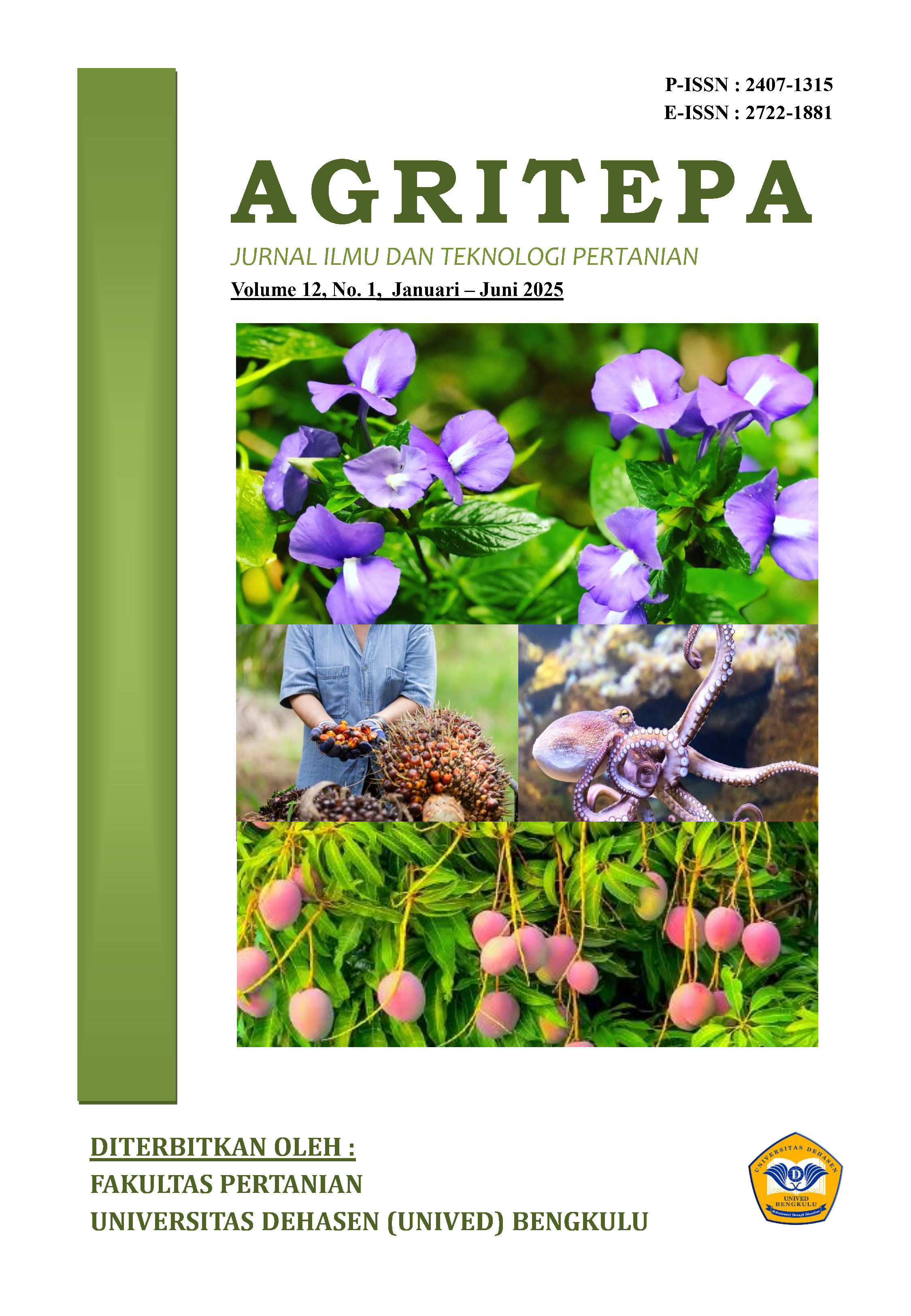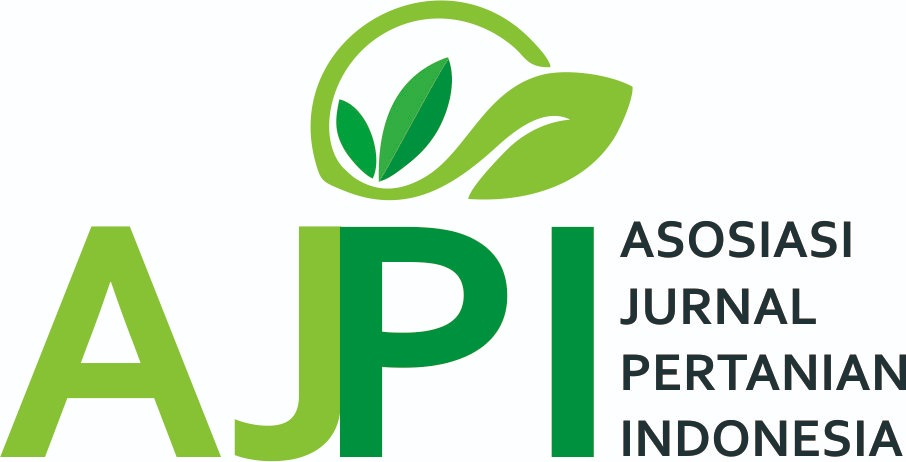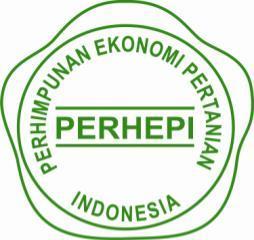The Total Flavonoid Content And Bioassay Test Characteristics Of Sorghum Extracts At Different Levels Of Drought Stress
Abstract
Purpose: to determine the total flavonoid content and seed germination characteristics in bioassay tests due to sorghum extracts' application at various drought stress levels. Extract materials were prepared from June to August 2024 at Bengkulu University Greenhouse, Kandang Limun Village, Bengkulu City, and bioassay tests were conducted in August 2024 at Pematang Gubernur, Muara Bangkahulu, Bengkulu City. Flavonoid analysis was performed at the Integrated Research and Testing Laboratory (LPPT) of Gadjah Mada University in August 2024. Methodology: This study used a completely randomized design (CRD) with one factor. Two sorghum varieties, Super 2 and Mandau, were planted with water stress treatment through watering patterns every day, every 3 days, and every 5 days. The experimental unit was a petri dish, and the experiment was repeated four times. The Petri dish bioassay method was applied in this experiment.Each petri dish was given 10 mL of water extract, and 25 mung bean seeds were planted and incubated for three days. Results: The results showed that the Mandau variety had the highest total flavonoid content with watering every 3 days (3991.34 µg/g), and the Super 2 variety had the lowest total flavonoid content with watering every day (3165.26 µg/g). The highest germination inhibition was achieved by the sorghum variety Mandau with watering every 5 days. The treatment produced the highest inhibition on the test plants, so it has the potential to be the best bioherbicide. Findings: The Mandau variety has the highest total flavonoid content with watering every 3 days, and the Super 2 variety has the lowest total flavonoid content with watering every day. Novelty: This study provides insight into the total flavonoid content and seed germination characteristics due to the application of sorghum extracts at various levels of drought stress. Originality: This study offers a detailed analysis of total flavonoid levels and seed germination characteristics in bioassay tests. Conclusion: The Mandau variety had the highest total flavonoid content with watering every 3 days. The Mandau sorghum variety achieved the highest germination inhibition with watering every 5 days. Type of Paper: empirical research article.
Downloads
References
Abdillah, D., Siswoyo, T. A., & Soedradjad, R. (2015). Pengaruh Cekaman Kekeringan terhadap Kandungan Fenolik dan Antioksidan Tanaman Sorgum (Sorghum bicolor L. Moench) pada Fase Awal Vegetatif. Berkala Ilmiah Pertanian, 1(1), 1-10.
Ali, M., Khan, S., Ahmed, Z., & Farooq, M. (2023). Sorghum as a climate-resilient crop: Adaptation strategies and potential benefits for sustainable agriculture. Journal of Agronomy and Crop Science, 209(4), 456–472. https://doi.org/10.1002/jac.2023
Bewley, J. D., & Black, M. (1994). Seeds: Physiology of Development and Germination. Plenum Press, New York.
Chen, S., Wei, H., & Zhang, C. (2018). Allelopathic Effects of Flavonoids from Invasive Plant Species on Native Plants: A Review. Allelopathy Journal, 44(1), 65-78.
Cheng, F., & Cheng, Z. (2021). "Research progress on the use of plant allelopathy in agriculture and the physiological and ecological mechanisms of allelopathy." Frontiers in Plant Science, 12, 642494.
Dong, N.-Q., & Lin, H.-X. (2021). Contribution of phenylalanine ammonia-lyase (PAL) to plant secondary metabolism and responses to environmental stresses. Frontiers in Plant Science, 12, 800.
Dong, X., & Lin, J. (2021). Flavonoids: Reactive oxygen species scavengers protecting plants under abiotic stress. Journal of Plant Physiology, 266, 153543.
Farooq, A., Farooq, N., Akbar, H., Hassan, Z. U., and Gheewala, S. H. (2023). A critical review of climate change impact at a global scale on cereal crop production. Agronomy, 13(1), 162. https://doi.org/10.3390/agronomy13010162
Farooq, M., Wahid, A., Kobayashi, N., Fujita, D., & Basra, S. M. A. (2009). Plant drought stress: Effects, mechanisms, and management. Agronomy for Sustainable Development, 29(1), 185-212.
Gniazdowska, A., & Bogatek, R. (2020). "Allelopathic interactions between plants: Multi-site action of allelochemicals." Acta Physiologiae Plantarum, 42, 25.
Khalid, S., Ahmad, T., & Anjum, M. A. (2020). Allelopathic Potential of Euphorbia helioscopia L. against Germination and Seedling Growth of Wheat and Brassica. Pakistan Journal of Weed Science Research, 26(2), 157-168.
Khalid, S., Shahid, M., & Bukhari, S. A. H. (2020). Allelopathic effects of drought-induced secondary metabolites on crop growth. Journal of Environmental Biology, 41(1), 1–10.
Kumar, S., & Pandey, A. K. (2013). Flavonoids: Health Benefits and Their Molecular Mechanism. In Flavonoids - From Biosynthesis to Human Health (pp. 1-16). IntechOpen.
Kustiawan, W., & Kusuma, A. (2019). Pengaruh cekaman abiotik terhadap kandungan flavonoid dan aktivitas antioksidan pada tanaman. Jurnal Agrobiologi Indonesia, 5(3), 45–52.
Little, N. G., DiTommaso, A., Westbrook, A. S., Ketterings, Q. M., and Mohler, C. L. (2021). Effects of fertility amendments on weed growth and weed–crop competition: A review. Weed Science, 69(2), 132–146. https://doi.org/10.1017/wsc.2021.1
Macías, F. A., Varela, R. M., & Torres, A. (2020). "Allelopathy: A natural alternative for weed control." Pesticide Biochemistry and Physiology, 168, 104641.
Saputri, M. (2019). Perbandingan Kadar Flavonoid Total Ekstrak Daun Sirsak (Annona muricata L.) Berdasarkan Kekeringan Bahan. KTI Mahasiswa, Poltekkes Kemenkes Palembang.
Susilo, E., Setyowati, N., Nurjanah, U., and Muktamar, Z. (2021a). Sorghum germination inhibition using its water extract cultivated in swampland with different irrigation patterns. In IOP Conference Series: Earth and Environmental Science (Vol. 694, No. 1, p. 012027). IOP Publishing.
Susilo, E., Setyowati, N., Nurjannah, U., and Muktamar, Z. (2021b). Effect of Swamp Irrigation Pattern and Sorghum Extract Concentration on Sorghum Seed Sprout. In 3rd KOBI Congress, International and National Conferences (KOBICINC 2020) (pp. 19-25). Atlantis Press.
Susilo, H., et al. (2021). "Potensi Ekstrak Air dari Ratun Tanaman Sorgum Sebagai Bioherbisida." Jurnal Agronida, 10(1), 17-26.
Syafrida, M., Darmanti, S., & Izzati, M. (2018). Pengaruh Suhu Pengeringan Terhadap Kadar Air, Kadar Flavonoid dan Aktivitas Antioksidan Daun dan Umbi Rumput Teki (Cyperus rotundus L.). Bioma, 20(1), 44-50.
Taiz, L., Zeiger, E., Møller, I. M., & Murphy, A. (2015). Plant Physiology and Development. Sinauer Associates, Sunderland, MA.
Tibugari, H., Chiduza, C., and Mashingaidze, A. B. (2020a). A survey of problem weeds of sorghum and their manage ment in two sorghum-producing districts of Zimbabwe. Cogent Social Sciences, 6(1), 1738840. https://doi.org/10.1 080/23311886.2020.1738840
Travlos, I. S., Cheimona, N., & Ralli, P. (2020). "Integrating cultural and mechanical methods for weed management in organic farming systems: A sustainable approach." Agronomy, 10(8), 1156.
Van Bruggen, A. H. C., He, M. M., Shin, K., Mai, V., Jeong, K. C., Finckh, M. R., & Morris, J. G. (2021). "Environmental and health effects of the herbicide glyphosate." Science of the Total Environment, 616-617, 255-268.
Zhang, Y., et al. (2021). "Enhancing Allelopathic Potential in Rice through Genetic Engineering: A Sustainable Approach to Weed Management." Frontiers in Plant Science, 12, 654321.
Copyright (c) 2025 Edi Susilo, Hesti Pujiwati (Author)

This work is licensed under a Creative Commons Attribution-ShareAlike 4.0 International License.
Author retains the copyright and grants the journal the right of first publication of the work simultaneously licensed under the Creative Commons Attribution-ShareAlike 4.0 License that allows others to share the work with an acknowledgement of the work's authorship and initial publication in this journal













